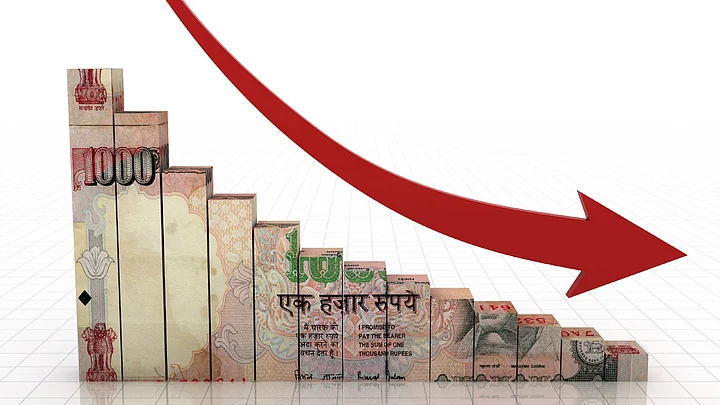- Government has lowered real GDP growth forecast for 2015-16 to 7-7.5% from 8.1-8.5% in the Economic Survey
- On a nominal basis, the economy is expected to expand 8.2%, lower than assumed 11.5% in the Budget
- Consumer price inflation is expected to remain within the RBI taget of about 6% in the current fiscal year
- Lower oil prices boosted growth in the current fiscal year, but such benefits may not be seen next year
Corporate balance sheets are expected to recover gradually; not much growth in private investment expected in 2016-17
- Exports may improve next fiscal year as IMF has expected global growth to rise in 2016
The Indian economy will grow a lot more slowly in the current fiscal year than previously estimated, the government admitted on Friday. It also warned that challenges to growth will persist in the next fiscal year too. The estimates for real GDP growth for the current fiscal year has been cut down to 7-7.5%, from 8.1-8.5% estimated in the Economic Survey tabled ahead of the Union Budget for 2015-16. This is mostly due to the collapse of rural demand caused by drought in most parts of the country and slowing of global economic growth. Yet, India will remain the world’s fastest growing major economy.
A mid-year review of the economy presented on Friday also revised down growth of nominal GDP – that is value of all economic activity measured at current market prices – to 8.2%. The union budget had estimated 11.5% growth in the nominal GDP, to make assumptions of tax revenue growth as well as likely fiscal deficit for the year. The downward revision of the nominal GDP will not affect fiscal consolidation, Chief Economic Advisor Arvind Subramanian said at a media briefing. The fiscal deficit will not exceed 3.9% of GDP assumed in the budget, as the government is expected to do well on revenue collection this year, thanks largely to the increased collection of taxes on petrol and diesel.
The mid-year review estimates that growth in the second half the current fiscal year will be better than that achieved in the first half. In particular, the nominal GDP growth in the first half is expected to be better in the second half, Mr Subramanian said.
Cheaper Oil Boosted Growth
Growth in the current fiscal year received a big boost from the sharp drop in crude oil prices globally. The economy is estimated to have received a 1-1.5 percentage point boost due to the collapse of oil prices. Some of that collapse in crude oil prices was passed on to consumers, lowering their fuel bills and allowing them to spend on other goods and services. Lower crude oil prices also allowed the government to increase taxes on petrol and diesel, and thus generate more resources for spending on various welfare and infrastructure projects.
The government’s petroleum subsidy bill also shrunk, allowing increased spending on more productive programmes. Thus, the boost to growth came mostly from private consumption and public spending. It is expected that the government will maintain the pace of spending till the end of the fiscal year. In years when the government’s revenues are under pressure, spending in the fourth quarter is ruthlessly slashed.The Chief Economic Advisor does not foresee any such expenditure cuts this fiscal.
Along with domestic consumption and public spending, corporate spending or investment by companies in new projects and expansion of facilities is critical for sustained growth. It has lagged either because companies continue to carry heavy debt burden, or where that’s not the problem, demand has not revived enough to necessitate fresh investment.
Exports Were the Weak Link
Exports are critical for growth of the Indian economy. With most of the world experiencing a slowdown, exports too suffered – mostly because they fetched lower values. Overall, exports declined by 17.4% in the first half of the fiscal year, with non-oil exports declining by 8.7%. The drag on the economy due to decline in exports is estimated at one percentage point relative to the previous year, according to the mid-year review. The only positive news on exports was that India’s manufacturing and services exports did not lose market share.
Better Growth Expected, but Risks Remain
India as well as the world’s growth is expected to improve in 2016-17. Higher growth in the major economies around the world augurs well for Indian exports. Mr Subramanian expects India’s exports to do much better next fiscal. “The adverse export shock suffered in this year could be reversed next year,” says the review. The outlook for inflation is, however, trickier to estimate. Much depends on global prices of commodities, chiefly oil. There is no expectation at present of any quick and early increase in prices of crude oil. “Slowing growth in China and a shift in composition of this growth away from energy intensive manufacturing will help keep oil prices soft,” estimates the review.
Rise in prices of manufactured goods depend on the increases in demand, and thus better utilisation of installed capacity of factories – demand is still way short of capacity to supply.
An increase in domestic consumption led by oil prices is also not seen. Rather if there is no further decline in oil prices next year, the boost that the economy got this year is only expected to recede.
(At The Quint, we question everything. Play an active role in shaping our journalism by becoming a member today.)
